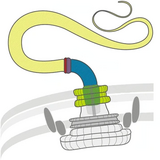
Back محرك جزيئي اصطناعي Arabic Synthetischer molekularer Motor German موتور مولکولی مصنوعی Persian Motor molecular Portuguese Молекулярные роторы Russian Молекулярні ротори Ukrainian

| Part of a series on |
| Microbial and microbot movement |
|---|
 |
| Microswimmers |
| Molecular motors |
Synthetic molecular motors are molecular machines capable of continuous directional rotation under an energy input.[2] Although the term "molecular motor" has traditionally referred to a naturally occurring protein that induces motion (via protein dynamics), some groups also use the term when referring to non-biological, non-peptide synthetic motors. Many chemists are pursuing the synthesis of such molecular motors.
The basic requirements for a synthetic motor are repetitive 360° motion, the consumption of energy and unidirectional rotation.[citation needed] The first two efforts in this direction, the chemically driven motor by Dr. T. Ross Kelly of Boston College with co-workers and the light-driven motor by Ben Feringa and co-workers, were published in 1999 in the same issue of Nature.
As of 2020, the smallest atomically precise molecular machine has a rotor that consists of four atoms.[3]
- ^ Palma, C.-A.; Björk, J.; Rao, F.; Kühne, D.; Klappenberger, F.; Barth, J.V. (2014). "Topological Dynamics in Supramolecular Rotors". Nano Letters. 148 (8): 4461–4468. Bibcode:2014NanoL..14.4461P. doi:10.1021/nl5014162. PMID 25078022.
- ^ Kassem, Salma; van Leeuwen, Thomas; Lubbe, Anouk S.; Wilson, Miriam R.; Feringa, Ben L.; Leigh, David A. (2017). "Artificial molecular motors". Chemical Society Reviews. 46 (9): 2592–2621. doi:10.1039/C7CS00245A. PMID 28426052.
- ^ Stolz, Samuel; Gröning, Oliver; Prinz, Jan; Brune, Harald; Widmer, Roland (2020-06-15). "Molecular motor crossing the frontier of classical to quantum tunneling motion". Proceedings of the National Academy of Sciences. 117 (26): 14838–14842. Bibcode:2020PNAS..11714838S. doi:10.1073/pnas.1918654117. ISSN 0027-8424. PMC 7334648. PMID 32541061.